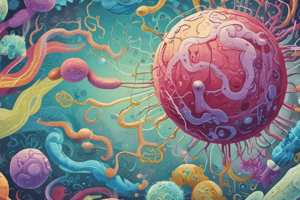Podcast
Questions and Answers
What distinguishes bacteria from viruses?
What distinguishes bacteria from viruses?
- Viruses can reproduce independently, unlike bacteria.
- Bacteria are unicellular, while viruses are multicellular.
- Bacteria can be classified by shape, whereas viruses cannot. (correct)
- Viruses contain a cellular structure, while bacteria do not.
Which of the following is NOT a classification method for bacteria?
Which of the following is NOT a classification method for bacteria?
- Shape
- Size (correct)
- Metabolic activity
- Oxygen requirements
Which characteristic enables bacteria to be classified as aerobic or anaerobic?
Which characteristic enables bacteria to be classified as aerobic or anaerobic?
- Their energy sources.
- Their method of reproduction.
- Their oxygen requirements. (correct)
- Their ability to move.
What type of organisms are classified as unicellular?
What type of organisms are classified as unicellular?
How do viruses reproduce?
How do viruses reproduce?
What is microbiology primarily concerned with?
What is microbiology primarily concerned with?
Which statement best describes the dual nature of microorganisms?
Which statement best describes the dual nature of microorganisms?
What type of organisms are included in the study of microbiology?
What type of organisms are included in the study of microbiology?
Microbiology plays a crucial role in which of the following areas?
Microbiology plays a crucial role in which of the following areas?
Which of the following best illustrates the importance of microbiology in human health?
Which of the following best illustrates the importance of microbiology in human health?
What are the characteristics of fungi?
What are the characteristics of fungi?
What defines parasites in the context mentioned?
What defines parasites in the context mentioned?
What aspect of medical importance do microbes play?
What aspect of medical importance do microbes play?
Which statement about infectious diseases is true?
Which statement about infectious diseases is true?
How are microbes associated with the concept of diseases?
How are microbes associated with the concept of diseases?
What is a primary concern associated with the use of antibiotics in treating bacterial infections?
What is a primary concern associated with the use of antibiotics in treating bacterial infections?
Which of the following is NOT an application of microbes?
Which of the following is NOT an application of microbes?
Which process involves using microorganisms to enhance the production of pharmaceuticals?
Which process involves using microorganisms to enhance the production of pharmaceuticals?
What role do microbes play in food preservation through fermentation?
What role do microbes play in food preservation through fermentation?
Which area of research focuses on the genetic manipulation of microorganisms?
Which area of research focuses on the genetic manipulation of microorganisms?
Flashcards are hidden until you start studying
Study Notes
Introduction to Microbiology
- Microbiology is the study of microorganisms, including bacteria, viruses, fungi, and parasites.
- Microorganisms play significant roles in the environment and human health, with both positive and negative impacts.
Types of Microorganisms
- Bacteria are single-celled organisms classified by their shape (spherical, rod-shaped, spiral) and oxygen requirements (aerobic, anaerobic).
- Viruses are obligate intracellular parasites that are smaller than bacteria and rely on host cells for replication.
- Fungi include yeasts and molds, some beneficial and some detrimental.
- Parasites live at the expense of other organisms and can be multicellular.
Medical Importance
- Microorganisms cause infectious diseases, which can be transmitted through various means.
- Bacteria cause infections, while viruses cause diseases.
- Antibiotics treat bacterial infections, but the emergence of antibiotic resistance poses a significant health threat globally.
Applications of Microorganisms
- Microorganisms are used in industrial applications, such as drug production and food fermentation.
- They play vital roles in scientific research, including genetic engineering and disease research.
Studying That Suits You
Use AI to generate personalized quizzes and flashcards to suit your learning preferences.




